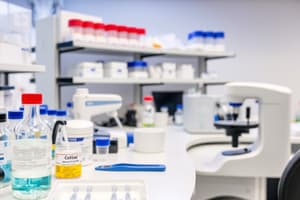Podcast
Questions and Answers
Which type of information is explicitly exempted from confidentiality?
Which type of information is explicitly exempted from confidentiality?
- Customer contact details
- Information used to respond to complaints (correct)
- Strategic business plans
- Product development blueprints
How should an organization generally treat its proprietary information?
How should an organization generally treat its proprietary information?
- As training material for all new hires
- As information to be shared with competitors
- As freely accessible to the public
- As confidential and not for general distribution (correct)
If a company's internal processes are proprietary, how should they be handled?
If a company's internal processes are proprietary, how should they be handled?
- Published in trade magazines
- Shared with any external party
- Kept confidential, except for specific needs like responding to complaints (correct)
- Disclosed during public interviews
What classification is assigned to information specifically related to complaint responses?
What classification is assigned to information specifically related to complaint responses?
What is the primary implication of information being considered 'proprietary'?
What is the primary implication of information being considered 'proprietary'?
What is one of the alternative names for certified reference materials?
What is one of the alternative names for certified reference materials?
Which term is NOT commonly associated with reference materials?
Which term is NOT commonly associated with reference materials?
What does the term 'reference standards' refer to?
What does the term 'reference standards' refer to?
Which of the following is synonymous with 'standard reference materials'?
Which of the following is synonymous with 'standard reference materials'?
Quality control materials are often referred to as what?
Quality control materials are often referred to as what?
Flashcards
Proprietary Information
Proprietary Information
Information owned by a company, not to be shared without permission.
Confidential Information
Confidential Information
Information that is meant to be kept private and secure.
Complaints Response
Complaints Response
The process of addressing issues raised by customers or clients.
Information Sharing
Information Sharing
Signup and view all the flashcards
Privacy Obligations
Privacy Obligations
Signup and view all the flashcards
Reference Materials
Reference Materials
Signup and view all the flashcards
Certified Reference Materials
Certified Reference Materials
Signup and view all the flashcards
Calibration Standards
Calibration Standards
Signup and view all the flashcards
Standard Reference Materials
Standard Reference Materials
Signup and view all the flashcards
Quality Control Materials
Quality Control Materials
Signup and view all the flashcards
Study Notes
ISO/IEC 17025:2017 Standard
- This standard outlines general requirements for the competence of testing and calibration laboratories.
- The standard is applicable to all organizations performing laboratory activities, irrespective of staff size.
- Laboratories are evaluated on their competence, impartiality, and consistency of operations.
- Customers, regulatory bodies, and accreditation organizations use this standard to assess laboratory competence.
General Requirements
-
Impartiality: Laboratories must operate without bias and structured to maintain impartiality.
-
Management commitment is crucial to maintaining impartiality.
-
Laboratories are responsible for safeguarding their impartiality from commercial, financial, or other pressures.
-
Laboratories must identify and address any potential threats to impartiality.
-
Confidentiality: Laboratories are responsible for managing all information obtained during testing and calibration activities.
-
Confidentiality is secured by legally enforceable commitments.
-
Customers are informed about public disclosure of their details beforehand.
Structural Requirements
- Laboratories must be legally distinct (a legal entity).
- Management structure must be identified with overall responsibility for the lab.
- A detailed outline of the lab's intended activities must be documented.
- Lab activities must conform to the standard's demands even when conducted off-site.
Resource Requirements
- Laboratories need sufficient personnel, facilities, equipment and support systems for operation.
- Staff competence, including education, training, and experience, must be documented.
- Procedures must exist for determining employee competence and ensuring appropriate personnel training.
- Laboratories need calibration protocols and labelled equipment to maintain traceability to the International Systems of Units (SI).
- Appropriate equipment must be in place for testing and calibration operations.
Process Requirements
- Procedures are required for reviewing requests, tenders, and contracts to ensure adequacy of resources, and suitability of the methods used.
- Laboratories must validate and document methods employed in testing and calibration processes.
- Procedures related to selecting personnel, training employees, supervising their performance, and authorizing personnel for specific lab tasks need to be documented.
- Procedures for handling test or calibration items must be established to ensure integrity, protection from damage or contamination, and clear identification methods.
- Procedures for evaluating measurement uncertainty are necessary for the validity of the lab's results.
Reporting of Results
- Results must be reviewed and authorized before release, presenting them accurately and clearly.
- Reports should include necessary details like the method used, date of sampling, unique identifiers, etc.
- Detailed reporting requirements are stipulated based on the type of report (e.g., test report, calibration certificate).
- Conformity with established specifications or standards must be reported.
- Reports must document any opinions or interpretations explicitly.
Studying That Suits You
Use AI to generate personalized quizzes and flashcards to suit your learning preferences.



